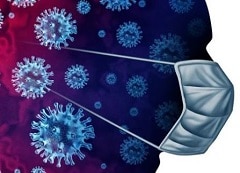I understand that the bold subheading is what the author wishes we would take away from their article but as I am attempting to articulate is the idea thatRead the article. Top line, immediately below the title.
That is the perspective of the entire article. There were some doubts expressed, however they were more along the lines of there are problems with some fabrics and the way people wear masks. The article also covers the expectations of what protection a mask provides. The goal of wearing a mask is to reduce the viral load, both of exhaled, but also of inhaled viral particles. Not to prevent transmission, but to reduce it. Hopefully to a level which your immune system can handle, but if not it can still reduce the impact of the virus. Fewer virions infecting you is better.
The assumption that they don't know the vectors by which this virus is spread is incorrect. They do. It's eyes, nose and mouth. The virus has other minor vectors, open wounds for example, but primarily it's eyes, nose and mouth. If you pull your mask off "because it's not comfortable", than you need to look into a different mask. We should also be protecting our eyes far more than we normally do. It turns out you can make an effective face covering that protects your eyes using an empty 2 liter soda bottle. Glasses can help too.
And yes, hand washing is important too. Frequently. 20 seconds or so per hour is not going to kill anyone but not doing so might. And the vector is not scratching your face. It's rubbing your eyes, or picking your nose, or sticking your finger in your mouth. Two of those are hard to do while wearing a mask. The third, well at least if you're wearing a mask you don't have 3. If you wear glasses, that might be at least partially covered.
A. We don't know the most common method of virus transmission. We don't even know the mechanics of influenza transmission and its been studied for years. The common accepted theory is that Influenza and Corona virus are most effective in being introduced to our mucus membrane be it eyes, nose or mouth but its still unknown if this is the only way. Here is an article published on a simulation of Influenza A transmission in a student office. https://www.ncbi.nlm.nih.gov/pmc/articles/PMC6121424/ But even this study is based on lots of assumptions and hypothesize and simply studies possible contact points and simulated virus spread with in a closed environment.
B. If we don't know the most common way Corona virus is spread, or how long it can last on surfaces then how can we say how effective wearing or not wearing a mask is. In fact it cannot be ruled out that wearing a mask can increase the chance that droplets containing the droplet are spread to common touch objects when an individual touches their mask to adjust, remove or place on their face. I am not ruling out that masks on their own when studied in a closed environment are effective at reducing virus spread when its only means of transmission is by passing through the mask. The studies on mask with in this context are pretty definitive as to their effectiveness, and if virus transmission was only possible by particles coming from the nose and mouth being airborne and then inhaled by others, then studying of masks and their effectiveness would be all we needed to know.
But we don't know if this vector is the primary way of spreading an infection, or if there is more common and better ways of spreading an infection with this vector simply being a small chance to start with. So if the goal of a mask is to reduce the initial virus load and masks only reduce an uncommon vector of virus transmission then all the effort on masks and mask studies is not were our focus should be. We should be focused on finding the highest risk vectors and then finding ways to mitigate them.











